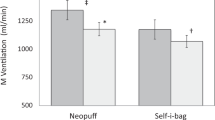Abstract
We designed the newly developed flexed two-finger chest compression technique for cardiopulmonary resuscitation (CPR) in infants to increase the quality of chest compression by considering the advantages and disadvantages of the two-thumb encircling hand technique and conventional two-finger technique. The aim of the study is to compare the performance of the flexed two-finger technique and the currently used two-thumb technique or two-finger technique for infant CPR. A total of 42 doctors conducted 2-min single-rescuer CPR on a cardiac arrest infant model using the two-thumb technique followed, in a random order, by the two-finger technique and the flexed two-finger technique. Although the ratio of the adequate compression depth was highest in the two-thumb technique, followed by the flexed two-finger technique and two-finger technique (100% [98–100] vs. 99% [80–100] vs. 76% [42–95], respectively, P < 0.001), the hand-off time of the two-thumb technique was significantly longer than in the two-finger technique and flexed two-finger technique (31 s [28–35] vs. 29 s [27–32] vs. 29 s [26–32], respectively, P < 0.001). The number of total chest compressions of the two-thumb technique was significantly lower than in the two-finger technique and flexed two-finger technique (150 [148–159] vs. 159 [149–173] vs. 162 [150–172], respectively, P < 0.001). The newly developed chest compression technique could provide adequate compression depth without increasing the hand-off time during single-rescuer infant CPR.
Trial registration: Clinical Research Information Service, KCT0002730.


Similar content being viewed by others
References
Maconochie IK, Bingham R, Eich C, Lopez-Herce J, Rodriguez-Nunez A, Rajka T, Van de Voorde P, Zideman DA, Biarent D, Paediatric Life Support Section Collaborators (2015) European Resuscitation Council Guidelines for Resuscitation 2015: Section 6. Paediatric life support. Resuscitation 95:223–248. https://doi.org/10.1016/j.resuscitation.2015.07.028
Udassi S, Udassi JP, Lamb MA, Theriaque DW, Shuster JJ, Zaritsky AL, Haque IU (2010) Two-thumb technique is superior to two-finger technique during lone rescuer infant manikin CPR. Resuscitation 81(6):712–717. https://doi.org/10.1016/j.resuscitation.2009.12.029
Lee SY, Hong JY, Oh JH, Son SH (2018) The superiority of the two-thumb over the two-finger technique for single-rescuer infant cardiopulmonary resuscitation. Eur J Emerg Med 25(5):372–376. https://doi.org/10.1097/MEJ.0000000000000461
Kim YS, Oh JH, Kim CW, Kim SE, Lee DH, Hong JY (2016) Which fingers should we perform two-finger chest compression technique with when performing cardiopulmonary resuscitation on an infant in cardiac arrest? J Korean Med Sci 31(6):997–1002. https://doi.org/10.3346/jkms.2016.31.6.997
Sample Size Estimation. Centre for Clinical Research and Biostatistics, The Chinese University of Hong Kong. Available from http://www2.ccrb.cuhk.edu.hk/stat/mean/tsmc_equality.htm. Accessed 7 Dec 2017
Jiang J, Zou Y, Shi W, Zhu Y, Tao R, Jiang Y, Lu Y, Tong J (2015) Two-thumb-encircling hands technique is more advisable than 2-finger technique when lone rescuer performs cardiopulmonary resuscitation on infant manikin. Am J Emerg Med 33(4):531–534. https://doi.org/10.1016/j.ajem.2015.01.025
Huynh TK, Hemway RJ, Perlman JM (2012) The two-thumb technique using an elevated surface is preferable for teaching infant cardiopulmonary resuscitation. J Pediatr 161(4):658–661. https://doi.org/10.1016/j.jpeds.2012.03.019
Christman C, Hemway RJ, Wyckoff MH, Perlman JM (2011) The two-thumb is superior to the two-finger method for administering chest compressions in a manikin model of neonatal resuscitation. Arch Dis Child Fetal Neonatal Ed 96(2):F99–F101. https://doi.org/10.1136/adc.2009.180406
Whitelaw CC, Slywka B, Goldsmith LJ (2000) Comparison of a two-finger versus two-thumb method for chest compressions by healthcare providers in an infant mechanical model. Resuscitation 43(3):213–216
Dorfsman ML, Menegazzi JJ, Wadas RJ, Auble TE (2000) Two-thumb vs. two-finger chest compression in an infant model of prolonged cardiopulmonary resuscitation. Acad Emerg Med 7(10):1077–1082
Houri PK, Frank LR, Menegazzi JJ, Taylor R (1997) A randomized, controlled trial of two-thumb vs two-finger chest compression in a swine infant model of cardiac arrest (see comment). Prehosp Emerg Care 1(2):65–67
Jo CH, Jung HS, Cho GC, Oh YJ (2015) Over-the-head two-thumb encircling technique as an alternative to the two-finger technique in the in-hospital infant cardiac arrest setting: a randomised crossover simulation study. Emerg Med J 32(9):703–707. https://doi.org/10.1136/emermed-2014-203873
Acknowledgements
The authors thank all participants from their hospital for their contribution to this study.
Author information
Authors and Affiliations
Contributions
Oh JH contributed to study conception and design. Yang D, Kim KH, Son S, and Cho J contributed to data acquisition. Seo KM and Oh JH contributed to data analysis and interpretation. Yang D and Oh JH contributed to the drafting of the manuscript and its critical revision for important intellectual content. All authors have read and approved the final version of the manuscript.
Corresponding author
Ethics declarations
Conflict of interest
The authors declare that they have no conflict of interest.
Additional information
Publisher’s Note
Springer Nature remains neutral with regard to jurisdictional claims in published maps and institutional affiliations.
Electronic supplementary material
Below is the link to the electronic supplementary material.
Rights and permissions
About this article
Cite this article
Yang, D., Kim, K.H., Oh, J.H. et al. Development and Evaluation of a New Chest Compression Technique for Cardiopulmonary Resuscitation in Infants. Pediatr Cardiol 40, 1217–1223 (2019). https://doi.org/10.1007/s00246-019-02135-x
Received:
Accepted:
Published:
Issue Date:
DOI: https://doi.org/10.1007/s00246-019-02135-x




